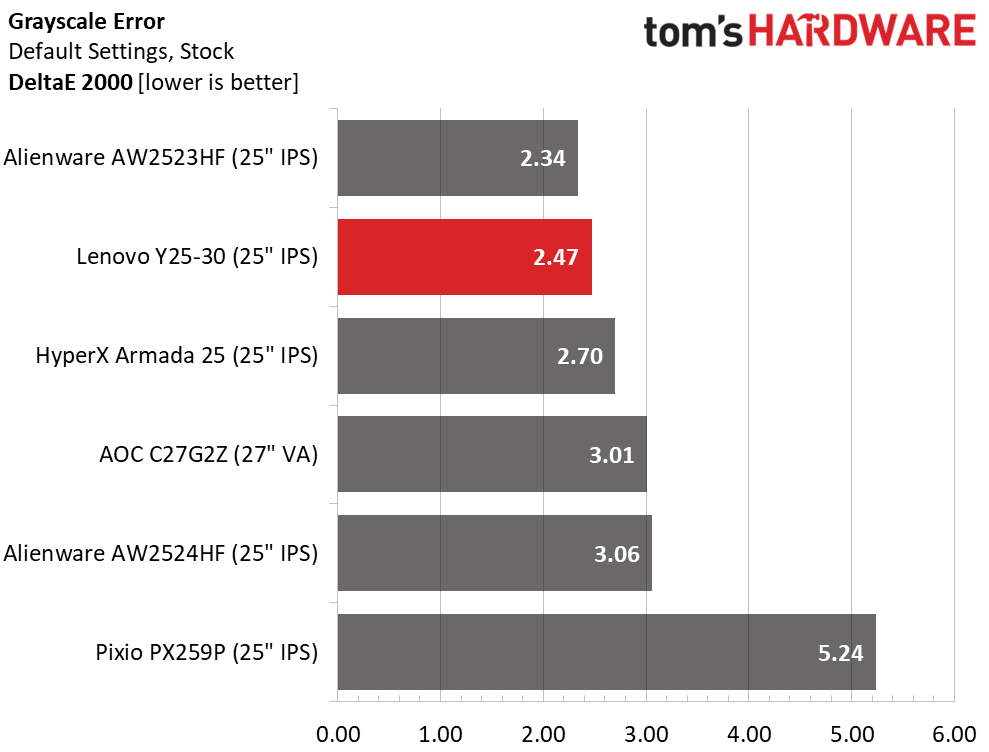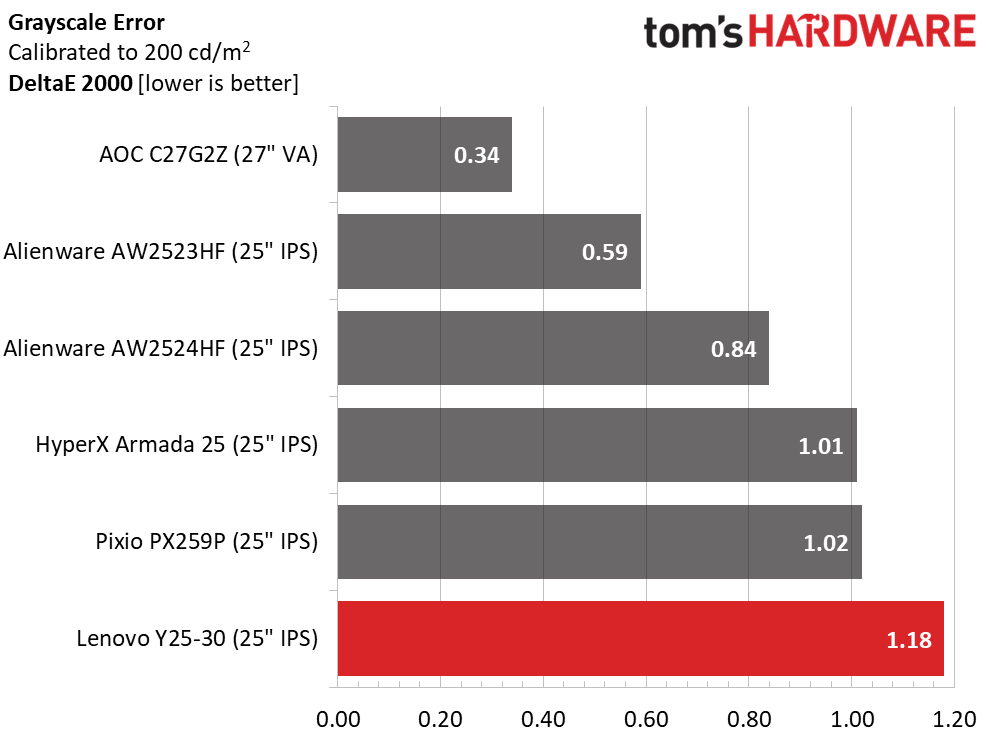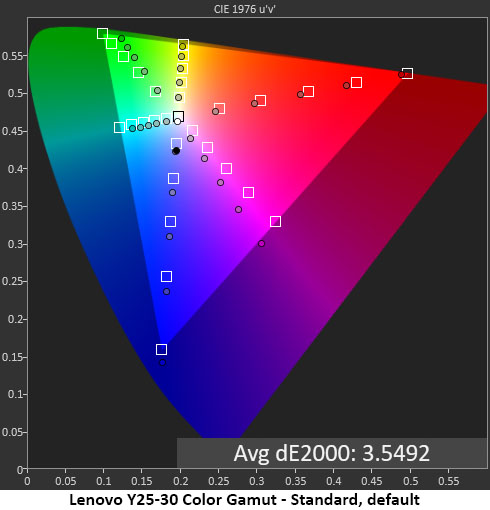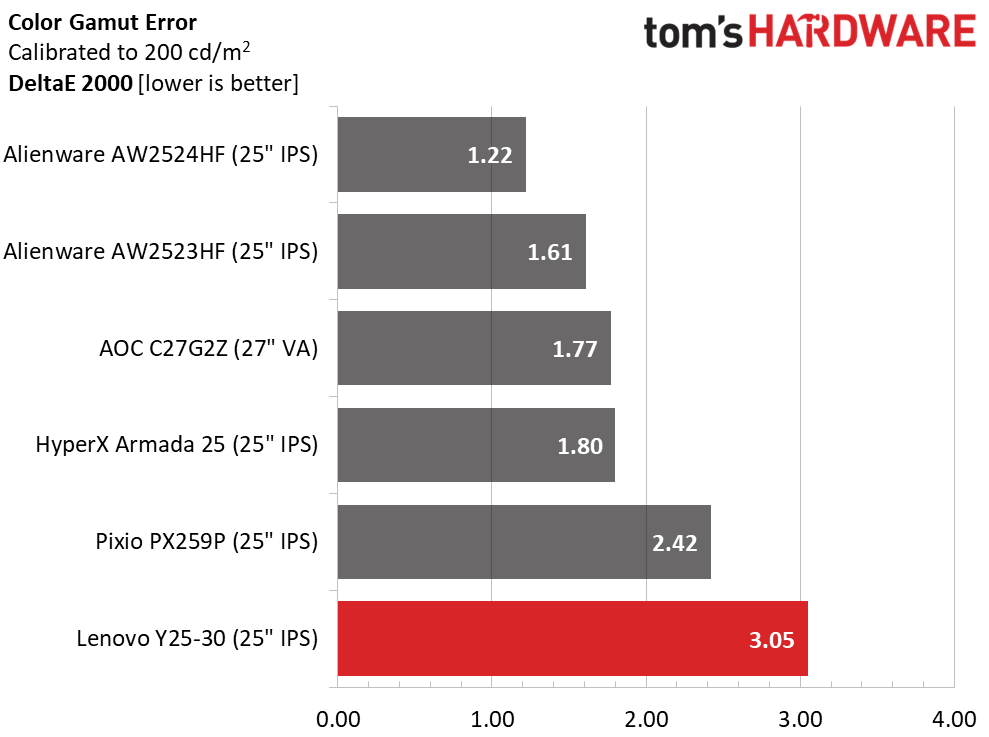Why you can trust Tom's Hardware
The Y25-30’s picture modes are found in the Game Setting menu with Standard as the default. It can be used without calibration and only has a few minor issues, which I’ll detail below.
Grayscale and Gamma Tracking
Our grayscale and gamma tests use Calman calibration software from Portrait Displays. We describe our grayscale and gamma tests in detail here.



In the Y25-30’s Standard picture mode, Warm color temp, most of the brightness steps have no visible error. 90 and 100% are a tad cool, but this will be hard to spot in practice. Gamma runs dark through most of the range, which helps improve perceived contrast. The error isn’t large, 2.36 is only a tad above the 2.2 reference. Lighter gamma presets in the OSD were too light for my liking as they washed out the image, so I went with the default setting.
Calibration required only a single click of the blue slider to achieve visually perfect grayscale tracking. Though gamma is still a bit dark, the picture looks very good with strong detail and saturated color.
Turning on the sRGB option in the Color Settings menu sets that gamut with a slightly warm grayscale and lighter gamma. In fact, it rides the 2.2 line closely except at 20 and 90% where it’s slightly light. This is a good setting for color-critical work but lacks the punch needed for gaming.
Comparisons




2.47dE puts the Y25-30 in second place in the out-of-box comparison. That’s solid performance for a budget monitor. Calibration improves the score to 1.18dE, but the other screens see a greater drop in error levels. Visually, there is no difference between any of the monitors once calibrated.
The Y25-30’s gamma tracking isn’t ideal, but it’s good enough to provide a colorful and saturated image. I opted for the default setting, which is too dark. However, one click lighter is too light. You may feel differently, and changing gamma without affecting color is possible.
Get Tom's Hardware's best news and in-depth reviews, straight to your inbox.
Color Gamut Accuracy
Our color gamut and volume testing use Portrait Displays’ Calman software. For details on our color gamut testing and volume calculations, click here.



The Y25-30’s default color gamut results show a few small errors. Green and magenta are off hue, while red and cyan are a bit under-saturated. Calibration helps a little, but the difference is barely visible. The image is pleasing with or without calibration. And the extra color saturation is a nice boost for SDR content.
sRGB color tracking is more accurate with just 1.90dE average error. Aside from slight hue errors in magenta, the chart is perfect. The Y25-30 is well suited for color-critical work in this color space.
Comparisons


3.05dE is just over the visual threshold, but I am hard-pressed to spot any magenta hue errors in the Y25-30’s picture. The other screens post better numbers, but few users will notice any difference in color between the six displays. This is very good performance.
With many displays hitting 90% of DCI-P3, the 240 Hz+ monitor category is slightly behind the numbers. But the Y25-30’s 85.59% is a respectable result. It’s only lacking a bit in green and cyan. The other colors are fully rendered. There is enough volume to improve SDR content without looking overblown, so that’s a plus. And the sRGB mode is very accurate, with nearly ideal coverage of 98.84%.
Test Takeaway: For the price, the Y25-30 offers decent color accuracy and can be used without calibration, which puts it ahead of most high-speed monitors. The dark gamma doesn’t seem to have a negative impact, but I’d like to see a choice that hits 2.2. Though gamut volume is a bit lower than average in general, it’s near the top of the speed monitor category so that’s a plus.
MORE: Best Gaming Monitors
MORE: How We Test PC Monitors
MORE: How to Buy a PC Monitor
MORE: How to Choose the Best HDR Monitor
Current page: Grayscale, Gamma and Color
Prev Page Brightness and Contrast Next Page HDR Performance
Christian Eberle is a Contributing Editor for Tom's Hardware US. He's a veteran reviewer of A/V equipment, specializing in monitors. Christian began his obsession with tech when he built his first PC in 1991, a 286 running DOS 3.0 at a blazing 12MHz. In 2006, he undertook training from the Imaging Science Foundation in video calibration and testing and thus started a passion for precise imaging that persists to this day. He is also a professional musician with a degree from the New England Conservatory as a classical bassoonist which he used to good effect as a performer with the West Point Army Band from 1987 to 2013. He enjoys watching movies and listening to high-end audio in his custom-built home theater and can be seen riding trails near his home on a race-ready ICE VTX recumbent trike. Christian enjoys the endless summer in Florida where he lives with his wife and Chihuahua and plays with orchestras around the state.
